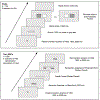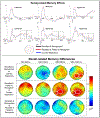Recallable but not recognizable: The influence of semantic priming in recall paradigms
- PMID: 33409957
- PMCID: PMC7994187
- DOI: 10.3758/s13415-020-00854-w
Recallable but not recognizable: The influence of semantic priming in recall paradigms
Erratum in
-
Correction to: Recallable but not Recognizable: The Influence of Semantic Priming in Recall Paradigms.Cogn Affect Behav Neurosci. 2021 Apr;21(2):445. doi: 10.3758/s13415-021-00872-2. Cogn Affect Behav Neurosci. 2021. PMID: 33594646 No abstract available.
Abstract
When people can successfully recall a studied word, they should be able to recognize it as having been studied. In cued-recall paradigms, however, participants sometimes correctly recall words in the presence of strong semantic cues but then fail to recognize those words as actually having been studied. Although the conditions necessary to produce this unusual effect are known, the underlying neural correlates have not been investigated. Across five experiments, involving both behavioral and electrophysiological methods (EEG), we investigated the cognitive and neural processes that underlie recognition failures. Experiments 1 and 2 showed behaviorally that assuming that recalled items can be recognized in cued-recall paradigms is a flawed assumption, because recognition failures occur in the presence of cues, regardless of whether those failures are measured. With event-related potentials (ERPs), Experiments 3 and 4 revealed that successfully recalled words that are recognized are driven by recollection at recall and then by a combination of recollection and familiarity at ensuing recognition. In contrast, recognition failures did not show that memory signature and may instead be driven by semantic priming at recall and followed at recognition stages by negative-going ERP effects consistent with implicit processes, such as repetition fluency. These results demonstrate that recall - long-characterized as predominantly reflecting recollection-based processing in episodic memory - may at times also be served by a confluence of implicit cognitive processes.
Keywords: Cued recall; Event-related potentials; Familiarity; Priming; Recollection.
Figures







Similar articles
-
Investigating the relationship between implicit and explicit memory: Evidence that masked repetition priming speeds the onset of recollection.Neuroimage. 2016 Oct 1;139:8-16. doi: 10.1016/j.neuroimage.2016.06.013. Epub 2016 Jun 9. Neuroimage. 2016. PMID: 27291494
-
Amount, not strength of recollection, drives hippocampal activity: A problem for apparent word familiarity-related hippocampal activation.Hippocampus. 2019 Jan;29(1):46-59. doi: 10.1002/hipo.23031. Epub 2018 Nov 8. Hippocampus. 2019. PMID: 30411437 Free PMC article.
-
On the functional significance of retrieval mode: Task switching disrupts the recollection of conceptual stimulus information from episodic memory.Brain Res. 2018 Jan 1;1678:1-11. doi: 10.1016/j.brainres.2017.09.032. Epub 2017 Oct 3. Brain Res. 2018. PMID: 28986084
-
A meta-analysis of event-related potential correlates of recognition memory.Psychon Bull Rev. 2023 Dec;30(6):2083-2105. doi: 10.3758/s13423-023-02309-y. Epub 2023 Jul 11. Psychon Bull Rev. 2023. PMID: 37434046 Free PMC article. Review.
-
Electrophysiological evidence for dissociable processes contributing to recollection.Acta Psychol (Amst). 1998 Apr;98(2-3):231-52. doi: 10.1016/s0001-6918(97)00044-9. Acta Psychol (Amst). 1998. PMID: 9621832 Review.
Cited by
-
An ERP measure of non-conscious memory reveals dissociable implicit processes in human recognition using an open-source automated analytic pipeline.Psychophysiology. 2023 Oct;60(10):e14334. doi: 10.1111/psyp.14334. Epub 2023 Jun 7. Psychophysiology. 2023. PMID: 37287106 Free PMC article.
-
A third kind of episodic memory: Context familiarity is distinct from item familiarity and recollection.bioRxiv [Preprint]. 2024 Oct 16:2024.07.15.603640. doi: 10.1101/2024.07.15.603640. bioRxiv. 2024. Update in: iScience. 2024 Nov 22;27(12):111439. doi: 10.1016/j.isci.2024.111439. PMID: 39071285 Free PMC article. Updated. Preprint.
-
Synchronous Theta Networks Characterize Successful Memory Retrieval.J Neurosci. 2025 Apr 16;45(16):e1332242025. doi: 10.1523/JNEUROSCI.1332-24.2025. J Neurosci. 2025. PMID: 40032520
-
Context familiarity is a third kind of episodic memory distinct from item familiarity and recollection.iScience. 2024 Nov 22;27(12):111439. doi: 10.1016/j.isci.2024.111439. eCollection 2024 Dec 20. iScience. 2024. PMID: 39758982 Free PMC article.
-
The Effect of Prior Knowledge of Color on Behavioral Responses and Event-Related Potentials During Go/No-go Task.Front Hum Neurosci. 2021 Jun 10;15:674964. doi: 10.3389/fnhum.2021.674964. eCollection 2021. Front Hum Neurosci. 2021. PMID: 34177494 Free PMC article.
References
Publication types
MeSH terms
Grants and funding
LinkOut - more resources
Full Text Sources
Other Literature Sources

